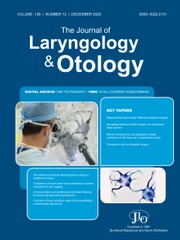Article contents
A volumetric three-dimensional evaluation of invasiveness of an endoscopic and microscopic approach for transmeatal visualisation of the middle ear
Published online by Cambridge University Press: 22 April 2021
Abstract
This study aimed to compare the necessary scutum defect for transmeatal visualisation of middle-ear landmarks between an endoscopic and microscopic approach.
Human cadaveric heads were used. In group 1, middle-ear landmarks were visualised by endoscope (group 1 endoscopic approach) and subsequently by microscope (group 1 microscopic approach following endoscopy). In group 2, landmarks were visualised solely microscopically (group 2 microscopic approach). The amount of resected bone was evaluated via computed tomography scans.
In the group 1 endoscopic approach, a median of 6.84 mm3 bone was resected. No statistically significant difference (Mann–Whitney U test, p = 0.163, U = 49.000) was found between the group 1 microscopic approach following endoscopy (median 17.84 mm3) and the group 2 microscopic approach (median 20.08 mm3), so these were combined. The difference between the group 1 endoscopic approach and the group 1 microscopic approach following endoscopy plus group 2 microscopic approach (median 18.16 mm3) was statistically significant (Mann–Whitney U test, p < 0.001, U = 18.000).
This study showed that endoscopic transmeatal visualisation of middle-ear landmarks preserves more of the bony scutum than a microscopic transmeatal approach.
- Type
- Main Articles
- Information
- Copyright
- Copyright © The Author(s), 2021. Published by Cambridge University Press
Footnotes
Dr M de Wolf takes responsibility for the integrity of the content of the paper
References
- 5
- Cited by


